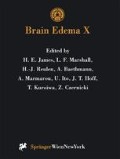Summary
Near infrared spectroscopy (NIRS) was used to asses changes in regional cerebral oxygen saturation (rSO2) in 8 head injured patients with an intracranial pressure (ICP) higher or lower than 25 mmHg (n = 4 for each group). NIRS values in the high ICP group (> 25 mmHg) were significantly lower than in the low ICP group (< 25 mmHg). In contrast, arterial pO2, pCO2, peripheral oxygen saturation and transcranial Doppler sonography (TCD) values were similar in both groups. To further investigate changes in rSO2 to changes in peripheral oxygen saturation and arterial pO2, patients of both groups underwent an artificial hyperoxygenation (50% O2) period of 3 minutes. Both groups revealed similar values in peripheral oxygen saturation, arterial pO2, and TCD velocities at the end of the hyperoxygenation period. However, rSO2 values in patients with an ICP > 25 mmHg were significant lower than in patients with an ICP < 25 mmHg after the hyperoxygenation period. In addition, patients with an ICP < 25 mmHg revealed a significant increase in rSO2 values at the end of the hyperoxygenation period, not detectable in patients with an ICP > 25 mmHg. Our results suggest that NIRS may be an additional diagnostic tool in the non-invasive evaluation of impaired cerebral microcirculation in patients with increased intracranial pressure.
Access this chapter
Tax calculation will be finalised at checkout
Purchases are for personal use only
References
Brazy JE (1991) Cerebral oxygen monitoring with near infrared spectroscopy: clinical application to neonates. J Clin Monit 7: 325–334
Brown R, Wright J, Royston R (1993) A comparison of two systems for assessing cerebral venous oxyhaemoglobin saturation during cardiopulmonary bypass in humans. Anesthesia 48: 697–709
Chan KH, Dearden NM, Miller JD (1993) Transcranial Doppler sonography in severe head injury. Acta Neurochir (Wien) 59: 81–85
Chance B, Smith DS, Delivoria-Papadoupoulos M, Younkin DP (1989) New techniques for evaluating metabolic brain injury in newborn infants. Crit Care Med 17: 465–471
Edwards AD, Wyatt JS, Richardson C, Delpy DT, Cope M, Reynolds ED (1988) Cotside measurement of cerebral blood flow in ill newborn infants by near infrared spectroscopy. Lancet 2: 770–771
Gopinath SP, Robertson CS, Grossman RG, Chance B (1993) Near-infrared spectroscopic localization of intracranial hematomas. J Neurosurg 79: 43–47
Kirkpatrick PJ, Smielewski P, Czosnyka M, Menon DK, Pickard JD (1995) Near-infrared spectroscopy use in patients with head injury. J Neurosurg 83: 963–970
Harris DNF, Bailey SM (1993) Near infrared spectroscopy in adults. Anesthesia 48: 694–696
Lou HC, Lassen NA, Friis-Hansen B (1979) Impaired autoreg-ulation of cerebral blood flow in the distressed newborn infant. J Pediatr 94: 118–121
Robertson CS, Contant CF, Goksalan ZL, Narayan RK, Grossman RG (1992) Cerebral blood flow, arteriovenous oxygen difference, and outcome in head injured patients. J Neurol Neurosurg Psychiatry 36: 559–566
Smith DS, Levy W, Maris M, Chance B (1990) Reperfusion hyperoxia in brain after circulatory arrest in humane. Anesthesiology 73: 12–19
Williams IM, Picton AJ, Hardy SC, Mortimer AJ, McCollum CN (1994) Cerebral hypoxia detected by near infrared spectroscopy. Anesthesia 49: 762–768
Author information
Authors and Affiliations
Editor information
Editors and Affiliations
Rights and permissions
Copyright information
© 1997 Springer-Verlag
About this paper
Cite this paper
Kampfl, A., Pfausler, B., Denchev, D., Jaring, H.P., Schmutzhard, E. (1997). Near Infrared Spectroscopy (NIRS) in Patients with Severe Brain Injury and Elevated Intracranial Pressure. In: James, H.E., et al. Brain Edema X. Acta Neurochirurgica Supplements, vol 70. Springer, Vienna. https://doi.org/10.1007/978-3-7091-6837-0_35
Download citation
DOI: https://doi.org/10.1007/978-3-7091-6837-0_35
Publisher Name: Springer, Vienna
Print ISBN: 978-3-7091-7418-0
Online ISBN: 978-3-7091-6837-0
eBook Packages: Springer Book Archive

